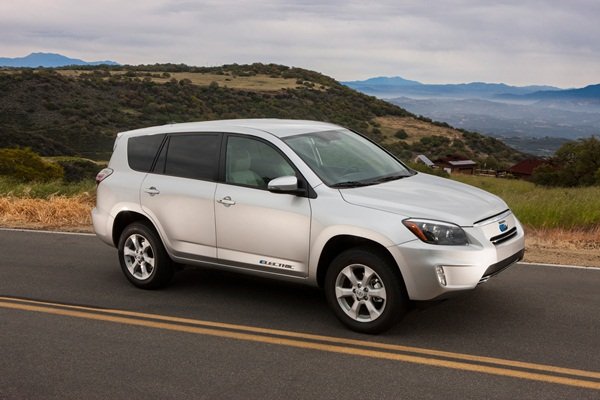Is the extra $12,000 worth it?
As with most things, comparing two similar but not identical items is challenging. Different needs drive the decision, along with the elusive desires that are oftentimes difficult to quantify.
We got a chance to get behind the wheel of the RAV4 EV recently at the Los Angeles Auto Show. In our admittedly brief time behind the wheel, we would have to answer the above posed question thusly – for our money, the LEAF wins hands down. Here’s why.
The RAV4 (gasoline version) was conceived, designed and executed as a four wheel drive compact sport utility vehicle. Meant to be capable of handling extreme weather driving conditions with its four wheel traction and the occasional off road excursion, the EV version will not be placed in those situations but retains the same basic platform. There is no four wheel drive electric alternative – the EV is front wheel drive only, with no plans currently to produce a four wheel drive version. This then, turns the RAV4 EV into a modern day compact station wagon. And the previous generation at that, as the new 2013 version of the RAV4 just shown at the auto show is not the version that the EV is based on. The RAV4 EV is based on the older RAV4 generation.
So why buy a RAV4 EV? It has more power and torque than the LEAF, but then again, it must haul around an additional 600+ pounds on a day to day basis. Still, with its significantly larger battery pack (41.8 kilowatt hours vs. 24 kilowatt hours for the LEAF) accounting for a significant chunk of that additional weight, it achieves an EPA rated 103 mile range. That easily tops the LEAFs 73 mile EPA range. But is it enough?
Most gasoline powered drivers say that they want 300 miles or more per tank. Not that most use it on any given day, but they want it. We think that the 103 mile range will not do anything to attract those buyers. One must then consider those that might say “The LEAF sounds good, but I would need it to go just a little further to be comfortable with it.” The RAV4 EV provides the answer to that issue. But at the cost of an additional $12,000 – not an insignificant sum for an extra 30 miles of range.
There is this to consider though – the RAV4 EV offers more rear leg room, more rear head room, and more cargo area. So if you often find yourself carrying four or five full sized adults (or teens) and their stuff (or perhaps large dogs), this might be a suitable alternative for you. But the reality remains – most electric vehicles do not take long trips. So could four adults sit in the LEAF to go out to dinner? Sure. And in our family’s situation, our rear seat passengers have yet to muddle their way through grade school, so the rear seat room is more than adequate for all five of us.
Finally, we must come back to the price. With a manufacturer suggested retail price (MSRP) of $49,800 the RAV4 EV is about twice the price of the average new car today and about $10,000-12,000 more than the LEAF. Toyota’s lease program offers a monthly payment of $599 for 36 months with $3,499 down. LEAF’s initial lease was around $349 per month when it first came out, but with current LEAF sales below Nissan’s expectations it can currently be had for around $267 per month for the top level SL trim with only $1,999 down. Better terms can be found in some regions. In our view, one must have pretty high regard for those rear seat passengers or cargo compartment items to justify that price differential. With the 2013 LEAF launch in the not too distant future, look for slightly greater range available due to improved efficiencies rather than battery chemistry changes. Add to that a lower price point for the expected reduced equipment version and it makes the LEAF look like an even more attractive choice.


I actually got mine for $2500 down (included first payment) and $225 including tax per month for 36 months, 12,000 miles per year. Factor in the CA rebate, and that zeros out the down payment and first payment. The deals are even more aggressive today on the remaining 2012’s. Given that price disparity, the Leaf is a no brainer.
Although I only paid $800 for a Level 2 charger and installed it myself, aside from only a handful of occasions, we probably could have just used the standard charger. We typically don’t go beyond 30% remaining, so charging it back to 80% wouldn’t take longer than overnight. That would have lowered the cost of entry even further.
Steve, thanks for the input!